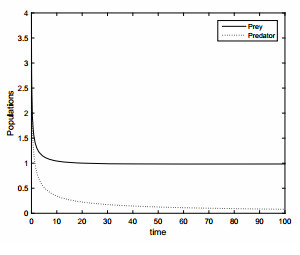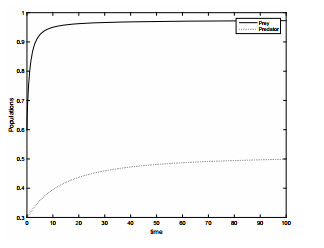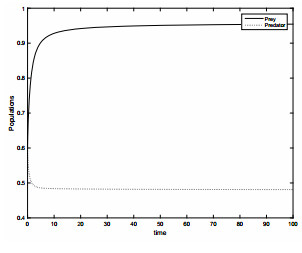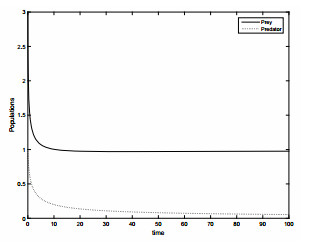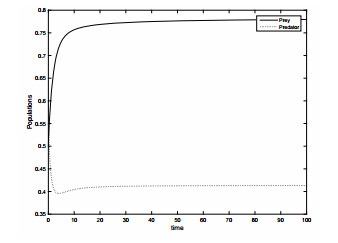|
[1]
|
E. Ahmed, A. M. A. EI-Sayed and H. A. A. EI-Saka, Equilibrium points stability and numerical solutions of fractional-order predator-prey and rabies models, Journal of Mathematical Analysis and Applications, 2007, 325(1), 542-553. doi: 10.1016/j.jmaa.2006.01.087
CrossRef Google Scholar
|
|
[2]
|
Y. Z. Bai and X. P. Zhang, Stability and Hopf Bifurcation in a diffusive predator-prey System with Beddington-DeAngelis functional response and time delay, Abstract Applied Analysis, 2011(2011), ID 463721.
Google Scholar
|
|
[3]
|
A. A. Berryman, The origin and evolution of predator-prey theory, Ecology, 1992, 73(5), 1530-1535. doi: 10.2307/1940005
CrossRef Google Scholar
|
|
[4]
|
R. Chinnathambi and F. A. Rihan, Stability of fractional-order prey-predator system with time-delay and Monod-Haldane functional response, Nonlinear Dynamics, 2018, 92(4), 1637-1648. doi: 10.1007/s11071-018-4151-z
CrossRef Google Scholar
|
|
[5]
|
W. H. Deng, C. P. Li and J. H. Lü, Stability analysis of linear fractional differential system with multiple time delays, Nonlinear Dynamics, 2007, 48(4), 409-406. doi: 10.1007/s11071-006-9094-0
CrossRef Google Scholar
|
|
[6]
|
J. W. Jia, Persistence and periodic solutions for a nonautonomous predator-prey system with type Ⅲ functional response, Journal of Biomathematics, 2001, 16(1), 59-62.
Google Scholar
|
|
[7]
|
Z. J. Liu and S. M. Zhong, An impulsive periodic predator-prey system with Holling type Ⅲ functional response and diffusion, Applied Mathematical Modelling, 2012, 36(12), 5976-5990. doi: 10.1016/j.apm.2012.01.032
CrossRef Google Scholar
|
|
[8]
|
D. Mukherjee, Persistence and bifurcation analysis on a predator-prey system of Holling type, Esaim Mathematical Modelling and Numerical Analysis, 2003, 37(2), 339-344. doi: 10.1051/m2an:2003029
CrossRef Google Scholar
|
|
[9]
|
D. Matignon, Stability result on fractional differential equations with applications to control processing, Computational Engineering in Systems Applications, 1996, 2, 963-968.
Google Scholar
|
|
[10]
|
P. Morin and C. Samson, Control of nonlinear chained systems: From the routh-hurwitz stability criterion to time-varying exponential stabilizers, IEEE Transactions on Automatic Control, 2000, 45(1), 141-146. doi: 10.1109/9.827372
CrossRef Google Scholar
|
|
[11]
|
I. Podlubny, Fractional Differential Equations: An Introduction to fractional derivatives, Fractional differential equations, to methods of their solution and some of their applications, first ed. Academic Press, California, 1998.
Google Scholar
|
|
[12]
|
I. Podlubny, Fractional Differential Equations, Academic Press, San Diego, 1999.
Google Scholar
|
|
[13]
|
F. A. Rihan, S. Lakshmanan, A. H. Hashish, R. Rakkiyappan and E. Ahmed, Fractional-order delayed predator-prey systems with Holling type-Ⅱ functional response, Nonlinear Dynamics, 2015, 80(1-2), 777-789. doi: 10.1007/s11071-015-1905-8
CrossRef Google Scholar
|
|
[14]
|
X. Y. Shi, X. Y. Zhou and X. Y. Song, Analysis of a stage-staturcted predator-prey model with Crowley-Martin function, Journal of Applied Mathematics and Computing, 2011, 36(1-2), 459-472. doi: 10.1007/s12190-010-0413-8
CrossRef Google Scholar
|
|
[15]
|
G. T. Sklaski and J. F. Gilliam, Functional responses with predator interference: viable alternative to Holling type Ⅱ model, Ecology, 2001, 82(11), 3083-3092. doi: 10.1890/0012-9658(2001)082[3083:FRWPIV]2.0.CO;2
CrossRef Google Scholar
|
|
[16]
|
P. Song, H. Y. Zhao and X. B. Zhang, Dynamic analysis of a fractional order delayed predator-prey system with harvesting, Theory in Biosciences, 2016, 135(1-2), 59-72. doi: 10.1007/s12064-016-0223-0
CrossRef Google Scholar
|
|
[17]
|
Y. F. Shao, B. X. Dai and Z. G. Luo, The dynamics of an impulsive one-prey multi-predators system with delay and Holling-type Ⅱ functional response, Applied Mathematics and Computation, 2010, 217(6), 2414-2424. doi: 10.1016/j.amc.2010.07.042
CrossRef Google Scholar
|
|
[18]
|
G. Tang, S. Tang and R. A. Cheke, Global analysis of a Holling type Ⅱ predator-prey model with a constant prey refuge, Nonlinear Dynamics, 2014, 76(1), 635-647. doi: 10.1007/s11071-013-1157-4
CrossRef Google Scholar
|
|
[19]
|
J. P. Tripathi, S. Abbas amd M. Thakur, Dynamic analysis of a prey-predator model with Beddington-Deangelis type function response incorporating a prey reguge, Nomlinear Dynamic, 2015, 80(1-2), 1-20. doi: 10.1007/s11071-014-1321-5
CrossRef Google Scholar
|
|
[20]
|
J. P. Tripathi, S. Tyagi and S. Abbas, Global analysis of a delayed density dependent predator-prey model with Crowley-Martin functional response, Communications in Nonlinear Science and Numerical Simulation, 2016, 30(1-3), 45-69. doi: 10.1016/j.cnsns.2015.06.008
CrossRef Google Scholar
|
|
[21]
|
F. Wei and Q. Fu, Hopf bifurcation and stability for predator-prey systems with Beddington-DeAngelis type functional response and stage structure for prey incorporating refuge, Applied Mathematical Modelling, 2016, 40(1), 126-134. doi: 10.1016/j.apm.2015.04.042
CrossRef Google Scholar
|
|
[22]
|
X. S. Wang, A simple proof of Descartes's rule of signs, The American Mathematical Monthly, 2004, 111(6), 525-526. doi: 10.1080/00029890.2004.11920108
CrossRef Google Scholar
|
|
[23]
|
H. Wang, Y. G. Yu, G. G. Wen and S. Zhang, Stability analysis of fractional-order neural networks with time delay, Neural Processing Letters, 2015, 42(2), 479-500. doi: 10.1007/s11063-014-9368-3
CrossRef Google Scholar
|
|
[24]
|
H. Wang, Dynamical analysis of fractional-order Hopfield neural networks with time delays, Beijing, PHD thesis of Beijing Jiaotong University(in Chinese), 2015.
Google Scholar
|
|
[25]
|
J. Zhou and C. Mu, Coexistence states of a Holling type Ⅱ predator-prey system, Journal of Mathematical Analysis and Applications, 2010, 369(2), 555-563. doi: 10.1016/j.jmaa.2010.04.001
CrossRef Google Scholar
|




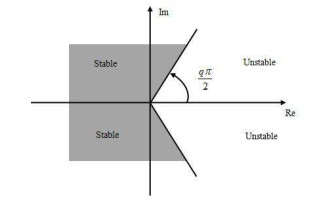

 DownLoad:
DownLoad:
